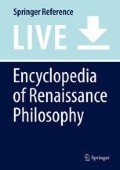Abstract
The abbacus school was a school for artisans’ and merchants’ sons, functioning in northern Italy (thirteenth to sixteenth century). It taught the use of Hindu-Arabic numerals and fundamental commercial arithmetic: the rule of three, monetary and metrological conversions, simple and composite interest, partnership, simple and composite discounting, alloying, the technique of a “single false position,” and, finally, simple area calculation. Topics like the double false position were not part of the curriculum, but they are often dealt with in the abbacus treatises; they probably served to show virtuosity in the competition for employment and pupils.
The manuscripts connected to the abbacus school tradition are of very different character. Some are messy problem collections, some orderly presentations, and a few genuine encyclopediae. Some are produced by mathematically incompetent compilers and some by the best European mathematicians of the age.
Traditionally but mistakenly, the abbacus books are to be derived from Leonardo Fibonacci’s Liber Abbaci and Practica Geometriae. As shown by closer inspection of the texts, they derive from direct inspiration from a broader Mediterranean environment, which had also inspired Fibonacci around 1200. After c. 1330, however, the abbacus tradition had become an autonomous current, no more significantly influenced by the Arabic or Ibero-Provençal world. Influences from Boethian and Euclidean arithmetic, though existing, remained peripheral.
Printing allowed the preparation and spread of the great works of Luca Pacioli, Girolamo Cardano, and Niccolò Tartaglia, as well as more modest books corresponding to the school curriculum. The former group, integrated with the theory of irrationals of Elements X, provided the basis for the renovation of algebra brought about by Viète and Descartes; the latter made possible the spread of abbacus-type teaching of basic applied arithmetic to the whole of Western Europe, where it stayed alive until c. 1960.
References
Primary Literature
Arrighi, Gino, ed. 1989. Maestro Umbro (sec. XIII), Livero de l’abbecho. (Cod. 2404 della Biblioteca Riccardiana di Firenze). Bollettino della Deputazione di Storia Patria per l’Umbria 86: 5–140.
Bombelli, Rafael. 1572. L’Algebra. Bologna: Giovanni Rossi.
Borghi, Pietro. 1484. Opera de arithmetica. Venezia.
Cardano, Girolamo. 1545. Artis magnae sive de regulis algebraicis, liber unus. Nürnberg: Petreius.
Feliciano da Lazesio, Francesco. 1526. Libro di arithmetica et geometria speculativa et praticale. Venezia.
Fibonacci, Leonardo. 1857. In Liber abbaci, ed. B. Boncompagni. Roma: Tipografia delle Scienze Matematiche e Fisiche.
Fibonacci, Leonardo. 1862. In Practica geometriae ed Opusculi, ed. B. Boncompagni. Roma: Tipografia delle Scienze Matematiche e Fisiche.
Franci, Raffaella. 2015. Un trattato d’abaco pisano della fine del XIII secolo (Ms. L.VI.47 della Biblioteca degl’Intronati di Siena). Bollettino di storia delle scienze matematiche 25: 9–96.
Larte de labbacho. 1478. Treviso.
Pacioli, Luca. 1494. Summa de Arithmetica Geometria Proportioni et Proportionalita. Venezia: Paganino de Paganini.
Stevin, Simon. 1585. L’arithmetique. Leiden: Plantin.
Stifel, Michael. 1544. Arithmetica integra. Nürnberg: Petreius.
Vogel, Kurt, 1977. Ein italienisches Rechenbuch aus dem 14. Jahrhundert (Columbia X 511 A13). (Veröffentlichungen des Deutschen Museums für die Geschichte der Wissenschaften und der Technik. Reihe C, Quellentexte und Übersetzungen, Nr. 33). München.
Secondary Literature
Arrighi, Gino. 1967. Un «programma» di didattica di matematica nella prima metà del Quattrocento (dal Codice 2186 della Biblioteca Riccardiana di Firenze). Atti e memorie dell'Accademia Petrarca di Lettere, Arti e Scienze di Arezzo, Nuova Serie 38 (1965–67): 117–128.
Black, Robert. 2007. Education and society in Florentine Tuscany: Teachers, pupils and schools, c. 1250–1500. Leiden/Boston: Brill.
Bonaini, F. 1857. Memoria unica sincrona di Leonardo Fibonacci, novamente scoperta. Giornale Storico degli Archivi toscani 1: 239–246.
van Egmond, Warren. 1980. Practical mathematics in the Italian renaissance: A catalog of Italian Abbacus manuscripts and printed books to 1600. Firenze: Istituto e Museo di Storia della Scienza.
Giusti, Enrico. 1991. L’algebra nel trattato d’abaco di Piero della Francesca: osservazioni e congetture. Bollettino di Storia delle Scienze mathematiche 11: 55–83.
Goldthwaite, Richard A. 1972. Schools and teachers of commercial arithmetic in renaissance Florence. Journal of European Economic History 1: 418–433.
Høyrup, Jens. 2005. Leonardo Fibonacci and Abbaco culture: A proposal to invert the roles. Revue d’Histoire des Mathématiques 11: 23–56.
Høyrup, Jens. 2007. Jacopo da Firenze's Tractatus Algorismi and early Italian Abbacus culture. Basel: Birkhäuser.
Høyrup, Jens. 2009. What did the Abbacus teachers aim at when they (sometimes) ended up doing mathematics? An investigation of the incentives and norms of a distinct mathematical practice. In New perspectives on mathematical practices: Essays in philosophy and history of mathematics, ed. Bart van Kerkhove, 47–75. Singapore: World Scientific.
Høyrup, Jens. 2010. Hesitating progress – The slow development toward algebraic symbolization in abbacus- and related manuscripts, c. 1300 to c. 1550. In Philosophical aspects of symbolic reasoning in early modern mathematics, ed. Albrecht Heeffer and Maarten Van Dyck, 3–56. London: College Publications.
Høyrup, Jens. 2012. Sanskrit-Prakrit interaction in elementary mathematics as reflected in Arabic and Italian formulations of the rule of three – and something more on the rule elsewhere. Gaṇita Bhāratī 34: 144–172.
Stedall, Jacqueline. 2010. From Cardano’s great art to Lagrange’s reflections: Filling a gap in the history of algebra. Zürich: European Mathematical Society.
Travaini, Lucia. 2003. Monete, mercanti e matematica. Le monete medievali nei trattati di aritmetica e nei libri di mercatura. Roma: Jouvence.
Ulivi, Elisabetta. 2002. Scuole e maestri d’abaco in Italia tra Medioevo e Rinascimento. In Un ponte sul mediterraneo: Leonardo Pisano, la scienza araba e la rinascita della matematica in Occidente, ed. Enrico Giusti, 121–159. Firenze: Edizioni Polistampa.
Ulivi, Elisabetta. 2011. Su Leonardo Fibonacci e sui maestri d’abaco pisani dei secoli XIII–XV. Bollettino di Storia delle Scienze Matematiche 31: 247–286.
Author information
Authors and Affiliations
Corresponding author
Editor information
Editors and Affiliations
Section Editor information
Additional information
Translations into English are due to the present author.
Rights and permissions
Copyright information
© 2018 Springer International Publishing AG
About this entry
Cite this entry
Høyrup, J. (2018). Abbacus School. In: Sgarbi, M. (eds) Encyclopedia of Renaissance Philosophy. Springer, Cham. https://doi.org/10.1007/978-3-319-02848-4_1135-1
Download citation
DOI: https://doi.org/10.1007/978-3-319-02848-4_1135-1
Received:
Accepted:
Published:
Publisher Name: Springer, Cham
Print ISBN: 978-3-319-02848-4
Online ISBN: 978-3-319-02848-4
eBook Packages: Springer Reference Religion and PhilosophyReference Module Humanities and Social SciencesReference Module Humanities

